
Buffalo Trace Distillery
by
Terry Sullivan
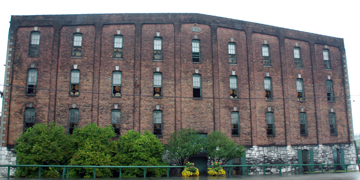 Summary: The site of Buffalo Trace Distillery is on 119 acres and at one time consisted of 114 buildings. Fewer buildings are used today. The warehouse building, pictured, is used for storing barrels. It is on the National Register of Historic Places. Take the tour during your visit. Tour guides personalize the tours and taylor them to your needs and interests.
Summary: The site of Buffalo Trace Distillery is on 119 acres and at one time consisted of 114 buildings. Fewer buildings are used today. The warehouse building, pictured, is used for storing barrels. It is on the National Register of Historic Places. Take the tour during your visit. Tour guides personalize the tours and taylor them to your needs and interests.
History
More than two centuries ago, millions of buffalo (bison) carved paths through America’s wilderness. These paths are called traces. One of the traces led to the Kentucky River and then beyond. Later, others would use these traces. Names like Daniel Boone and George Rogers Clark as well as numerous settlers expanded westward. By 1775 a settlement was built at the point where the buffalo crossed the Kentucky River. Settlers found the terroir of the area perfect for growing grains.
 The first distillery dates from 1787. A modern distillery was built on the site in 1857. It was the first distillery to use steam power in the production process. Later, it was the first distillery to create a climate-controlled aging room. During Prohibition, the distillery was allowed to continue to make bourbon for medicinal purposes. In1999 the George T. Stagg distillery was renamed Buffalo Trace.
The first distillery dates from 1787. A modern distillery was built on the site in 1857. It was the first distillery to use steam power in the production process. Later, it was the first distillery to create a climate-controlled aging room. During Prohibition, the distillery was allowed to continue to make bourbon for medicinal purposes. In1999 the George T. Stagg distillery was renamed Buffalo Trace.
Tours
Buffalo Trace Distillery is the oldest continuously operating distillery in the country and has been placed on the National Register for Historic Places. Visitors can choose from two tours. The general tour will give visitors an overview of the distillery, its buildings and the bourbon making process. The hardhat tour takes people through the distillery and warehouse. Guides will tweak the tour to meet the needs of the tour group. Elementary school groups also take the tour. The guides discuss Kentucky history and the part bourbon played in the history of the state.
Angela Traver gave us the hardhat tour. She pointed out the mechanics shop. If equipment breaks or needs a part, machinists can repair and make parts. Angela spoke of the importance of the limestone water. She related a story of a 23 year-old barrel that was opened to reveal a black liquid. The bourbon was destroyed by iron. It was theorized that the barrel had a nail in the wood. The iron from the nail ruined the bourbon. Limestone water helps filter iron out of the water.
We toured the area where trucks pull up with loads of grain. The moisture levels of the corn are checked. If not appropriate, a truck will be sent away. However this rarely occurs. We observed ten,100-gallon mash cookers where the corn is cooked for about five hours. Rye or wheat is then added and continued to cook. The mash is then put into a 92,000-gallon fermenter. Fermentation can take up to five days. We tasted a mash recently placed in the fermenter. The mash had a corn taste and was sweet. After fermenting for a few days, the mash tasted sour. At this point it is called sour mash and is about nine percent alcohol.
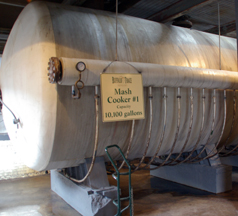
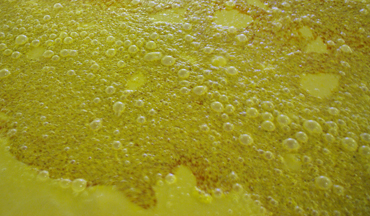
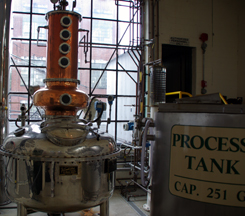 We toured an area where a small micro-distillery was set up. This provides experimenting with a number of the variables. The distillers want to learn new things and are always interested in making the bourbon better. With the micro-still it is possible to produce small quantities of bourbon rather than a large number of barrels. If the experiment doesn’t go as hoped for, there are fewer barrels of bourbon to lose.
We toured an area where a small micro-distillery was set up. This provides experimenting with a number of the variables. The distillers want to learn new things and are always interested in making the bourbon better. With the micro-still it is possible to produce small quantities of bourbon rather than a large number of barrels. If the experiment doesn’t go as hoped for, there are fewer barrels of bourbon to lose.
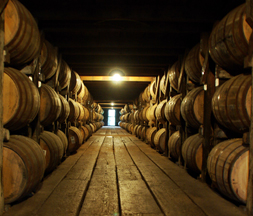 We visited Warehouse C that ages 24,017 barrels. This warehouse was built in 1881 and is an example of rick construction. Massive wood beams can bear the weight of the barrels. The foundation of the warehouse was made from Kentucky River marble quarried a short distance away. The brick walls are 18 inches thick and help control the building’s temperature. We then observed the bottling line. Several people work along the bottling line performing different tasks including labeling and sealing the bottles.
We visited Warehouse C that ages 24,017 barrels. This warehouse was built in 1881 and is an example of rick construction. Massive wood beams can bear the weight of the barrels. The foundation of the warehouse was made from Kentucky River marble quarried a short distance away. The brick walls are 18 inches thick and help control the building’s temperature. We then observed the bottling line. Several people work along the bottling line performing different tasks including labeling and sealing the bottles.
Tastings
The tour ended in the tasting room where we tasted three products. White Dog was a newly distilled spirit recently off the still. It did not age in a barrel. It was a clear color and had a grainy especially corn aroma and taste. There was sweetness on the taste and finish. Buffalo Trace was a golden color with a caramel aroma and taste. There was heat on the finish and it offered a long caramel aftertaste. A unique product was the Buffalo Trace Cream Liqueur. It had a creamy sweet taste and makes a delicious dessert drink.

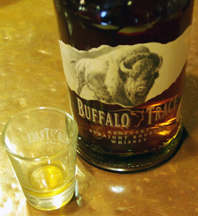
Buffalo Trace Distillery provides an informative and educational tour. You can learn about Kentucky history and the bourbon making process when you take the tour.
Buffalo Trace Distillery
1001 Wilkinson Blvd.
Frankfort, KY 40601
GPS: N38º 13.000’ W84º 52.162’
Visit these distilleries that advertise with Distilling - Wine Trail Traveler.
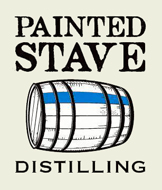 |
 |
|
| Painted Stave | Pinch Gut Hollow Distillery |
